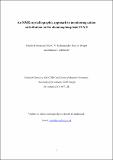An NMR crystallographic approach to monitoring cation substitution in the aluminophosphate STA-2
View/
Date
2014Author
Grant ID
EP/E041825/1
F/00 268/BJ
MRTN-CT-2004-005503-INDENS-P WRIGHT
EP/J501542/1
EP/F018096/1
EP/J501542/1
Keywords
Metadata
Show full item recordAbstract
The substitution of the divalent cations Mg2+ and Zn2+ into the aluminophosphate (AlPO) framework of STA-2 has been studied using an “NMR crystallographic” approach, combining multinuclear solid-state NMR spectroscopy, X-ray diffraction and first-principles calculations. Although the AlPO framework itself is inherently neutral, the positive charge of the organocation template in an as-made material is usually balanced either by the coordination to the framework of anions from the synthesis solution, such as OH− or F−, and/or by the substitution of aliovalent cations. However, the exact position and distribution of the substituted cations can be difficult to determine, but can have a significant impact upon the catalytic properties a material exhibits once calcined. For as-made Mg substituted STA-2, the positive charge of the organocation template is balanced by the substitution of Mg2+ for Al3+ and, where required, by hydroxide anions coordinated to the framework. [27] Al MAS NMR spectra show that Al is present in both tetrahedral and five-fold coordination, with the latter dependent on the amount of substituted cations, and confirms the bridging nature of the hydroxyl groups, while high-resolution MQMAS spectra are able to show that Mg appears to preferentially substitute on the Al1 site. This conclusion is also supported by first-principles calculations. The calculations also show that 31P chemical shifts depend not only on the topologically-distinct site in the SAT framework, but also on the number of next-nearest-neighbour Mg species, and the exact nature of the coordinated hydroxyls (whether the P atom forms part of a six-membered ring, P(OAl)2OH, where OH bridges between two Al atoms). The calculations demonstrate a strong correlation between the 31P isotropic chemical shift and the average bond angle. In contrast, for Zn substituted STA-2, both X-ray diffraction and NMR spectroscopy show less preference for substitution onto Al1 or Al2, with both appearing to be present, although that into Al1 appears slightly more favoured.
Citation
Seymour , V R , Eschenroeder , E C V , Wright , P A & Ashbrook , S E 2014 , ' An NMR crystallographic approach to monitoring cation substitution in the aluminophosphate STA-2 ' , Solid State Nuclear Magnetic Resonance . https://doi.org/10.1016/j.ssnmr.2014.10.007
Publication
Solid State Nuclear Magnetic Resonance
Status
Peer reviewed
ISSN
0926-2040Type
Journal article
Description
The authors thank the Leverhulme Trust (F/00 268/BJ), EPSRC (EP/E041825/1, EP/J501542/1, and EP/F018096/1) and the European Commission FP6 Marie Curie Research Training Network “INDENS” (MRTN-CT-2004–005503), and the Leverhulme Trust (F/00 268/BJ) for support. Accepted 23rd October 2014.Collections
Items in the St Andrews Research Repository are protected by copyright, with all rights reserved, unless otherwise indicated.

